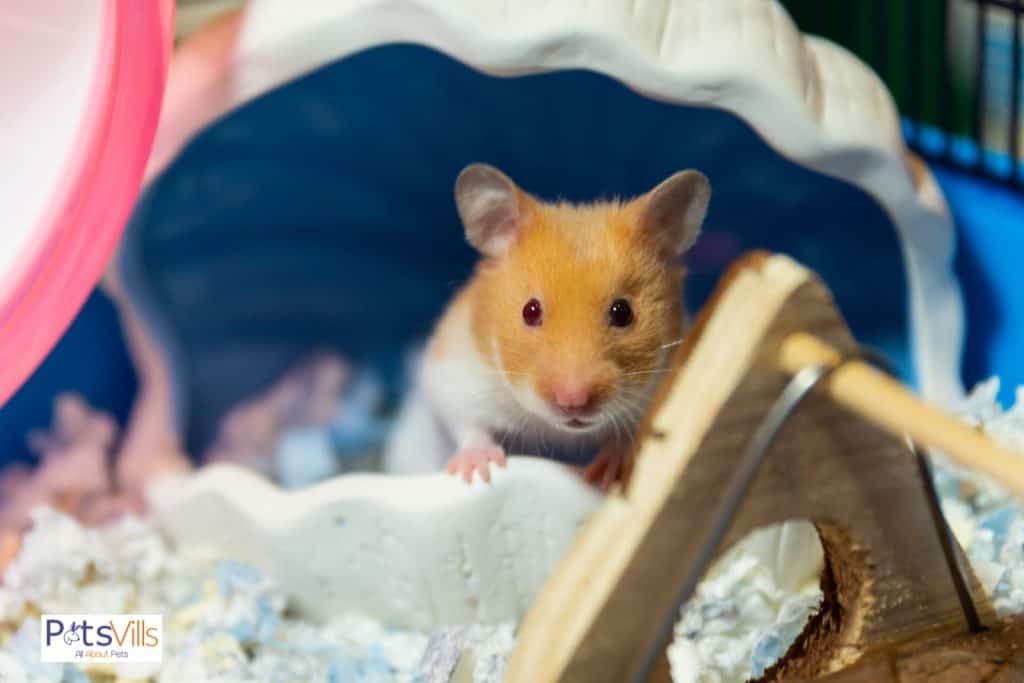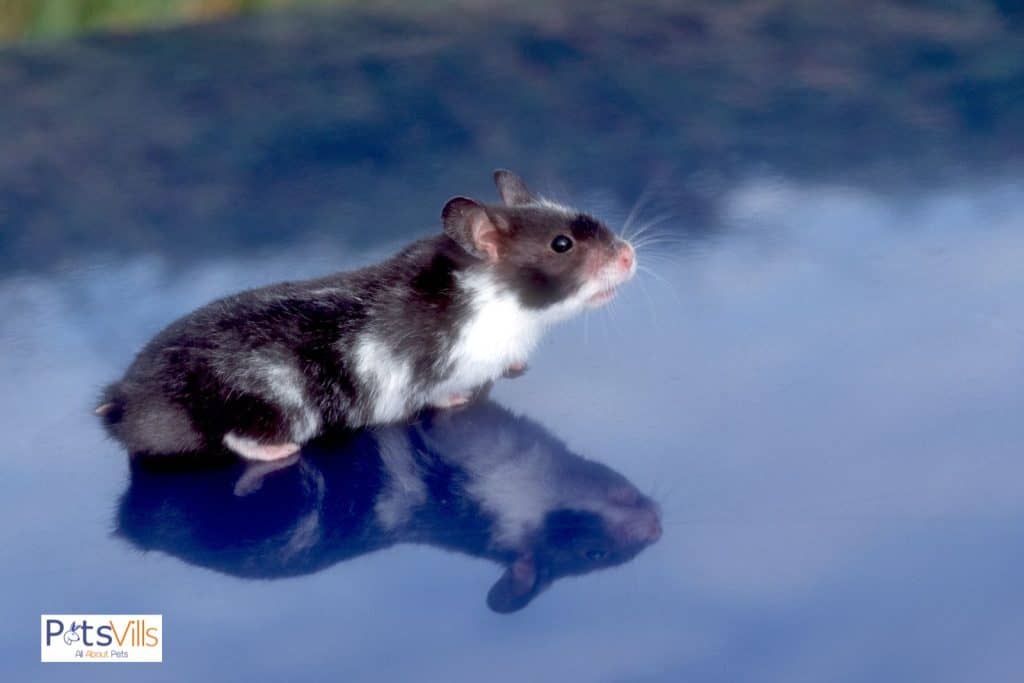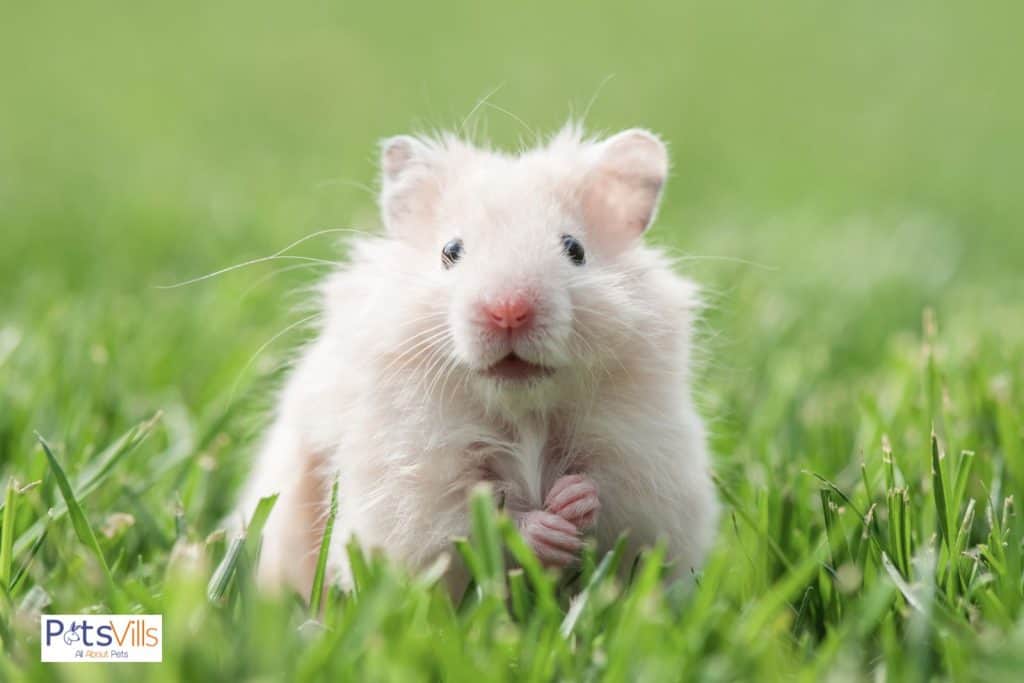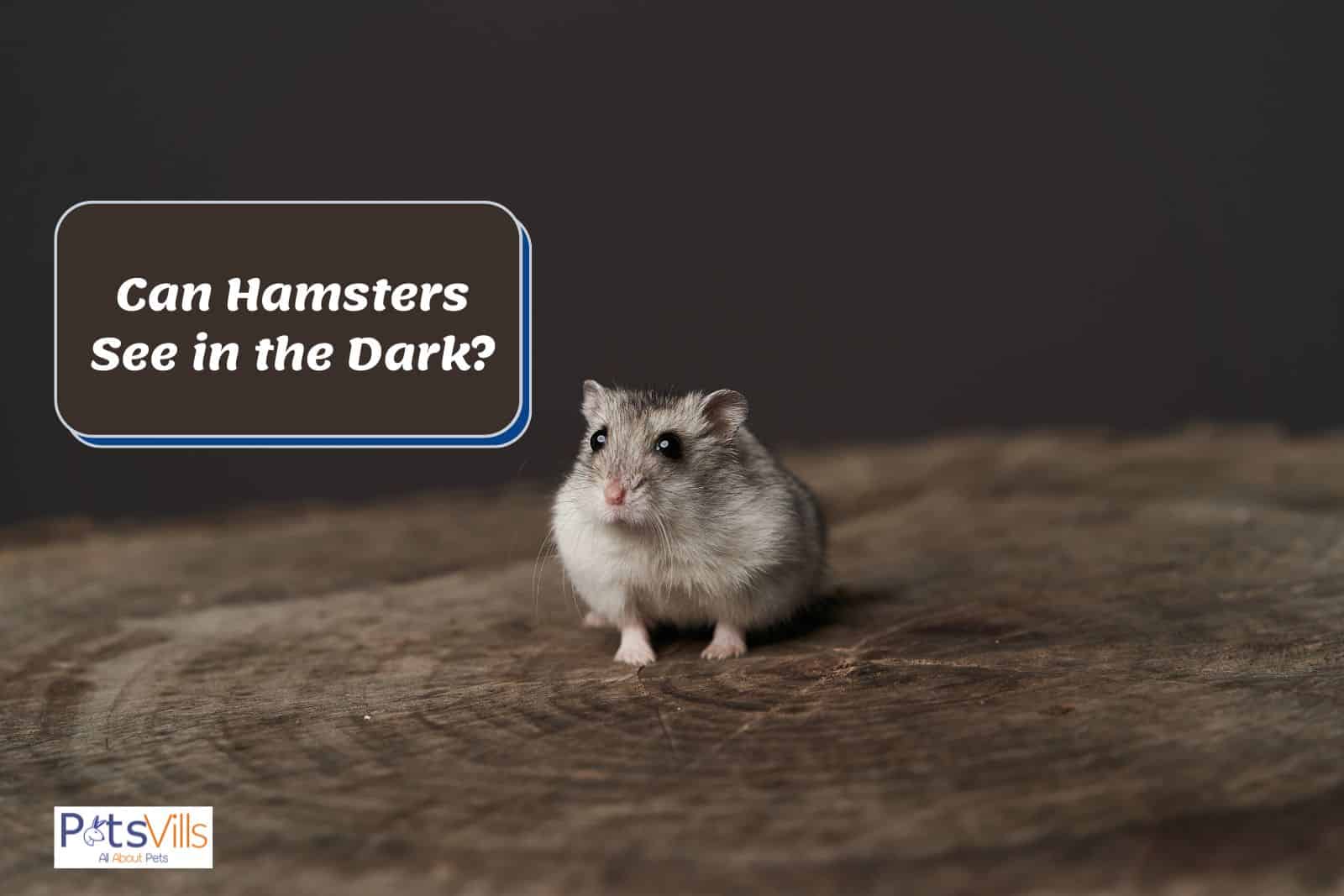Is your hamster very active at night, and you’re wondering: “can hamsters see in the dark?” Hamsters can see in the dark, just not very well.
Their vision is more evident in medium-low lighting at dawn and dusk.
Read on to learn more about hamsters’ eyesight and other senses.
Table of Contents
Key Takeaways
- Hamsters can’t see well, and their field of vision is very narrow.
- Their incredible senses of smell and hearing help them perceive their environment.
- Hamsters need just a little bit of light to see.
- Hamsters can see green and blue light.
Hamsters Have Poor Eyesight
Hamsters’ eyesight is very poor. They are blind since the time they are born. Their vision develops as they age, but it doesn’t get much better.
During the day, adult hamsters cannot see further than a few inches in front of them. That’s why hamsters will usually stay in their burrow for safety.

At night, hamsters also cannot see very well, especially when it’s pitch black.
So your pet hamsters are at risk of getting themselves in harm’s way. If you leave the hamsters up on a desk, monitor them closely or put a fence to prevent them from falling off.
Because of their poor vision, they may have difficulty recognizing you from far away. Hamsters have good hearing and the ability to recognize different voices.
Speak gently while playing with your pet hamster so they’ll recognize your voice.
Then, speak to them when you walk into the room, and they’ll know it’s you.
Are Hamsters Nocturnal?
Are hamsters nocturnal? Yes, hamsters are nocturnal creatures. They are most active in the wee hours, foraging for food, burrowing holes in the ground, and mating.

Being nocturnal creatures, hamsters have many benefits. One of them is going undetected by predators. They can move around without worrying a predator will eat them.
But some predators come out at night too. Some snakes, owls, badgers, and wildcats are nocturnal and hunt only at night. So hamsters will create burrows and use them for their safety.
Since they are nocturnal animals, they don’t need good vision. Instead, they rely on their senses of hearing and smell.
While in their burrow, they can detect intruders coming into it or nearby. Also, they can sniff out other hamsters with their powerful sense of smell.
Hamsters See Best at Dawn and Dusk
Hamsters see best at dawn and dusk since they are sensitive to light but still need some light to see. (1)
During the day, the bright sunlight can hurt their eyes. Therefore, they always have some type of cover to hide from the bright light.

Can hamsters see in the dark? At night, when it’s pitch black, hamsters are pretty much blind; they don’t have night vision. They will move around using their senses of smell and hearing.
You’ll probably notice how your pet is more active at the start of the day and at night.
RELATED: Do Hamsters Like Sunlight?
Do Hamsters See in Color?
Mostly, no. According to studies, hamsters likely have “sensitivity to blue and green light (…) and minimum sensitivity to red light. (…) Sensitivity to white light was intermediate.” (2)
But the hamster’s vision is primarily monochromatic.
Color vision is determined by the cones animals have in their eyes and how their brain interprets signals sent by these cones.
Eye cones are cells that are sensitive to light. Each type of cone is responsible for recognizing one light color.
Humans have three cone types, being able to recognize many colors that are seen because of the intersection of these cones.
Hamsters only have one. (3) So they don’t have real color vision.
Hamsters Can Hear Very Well
Even though hamsters have very poor eyesight, they have a developed sense of hearing. (4) Hamsters can hear sound far beyond humans.
With their hearing and their specially tuned ears, they can sense dangers long before they reach them.
Hamsters use squeaks and other low-frequency sounds to communicate with each other. Humans and most other animals can’t hear anything at the hamster’s frequency level.
Because their ear is really sensitive, it’s essential to make sure the sounds around them aren’t too loud. This means keeping TV and stereo far away from them.
If the noise is too loud, it could prevent the hamster from relaxing and could even cause them to be stressed.
To help hamsters relax, you can play a lovely classical song at a low volume.
Hamsters Have A Keen Sense of Smell
Besides their excellent sense of hearing, hamsters also have a great sense of smell. The smell is another way for hamsters to communicate with each other.

All hamsters release pheromones, a smell with information on it. This smell will let other hamsters know whose territory it is, see if they are a male or female, and recognize each other.
Also, the hamster mothers release pheromones to help hamster babies recognize them. In the burrow, where it’s usually dark most of the time, using the scent will help the mother locate their babies too.
When foraging for food, hamsters use their sense of smell to locate it. They will use their nose to sniff out seeds, grains, fruits, and vegetables. Because of their keen smell, they can even locate food under dirt and debris.
Also, their sense of smell allows them to differentiate between spoiled and fresh food. Hamsters will only eat fresh food and store them in their burrow.
FAQs
Do hamsters get lonely at night?
No, hamsters rarely get lonely, even at night. They don’t live in groups, and when they do, they fight most of the time.
How do hamsters see humans?

Since they have such bad vision, hamsters won’t recognize you that well with their eyes, but by your scent and voice.
Conclusion
So, can hamsters see in the dark? No. They are nocturnal rodents, but their olfactory and auditory senses guide them.
As you can see, they have terrible vision, unable to see colors properly. So hamster owners should provide them with a place that has a cover and dim light.

So, are your hamsters active at night? Let us know in the comments section!
References
- 1. Siegel HI. The Hamster: Reproduction and Behavior [Internet]. Google Books. Springer Science & Business Media; 2012 [cited 2022 Nov 16]. Available from: https://books.google.com.br/books?id=uqnVBwAAQBAJ&printsec=frontcover#v=onepage&q&f=false
- 2. Boulos Z. Wavelength dependence of light-induced phase shifts and period changes in hamsters. Physiology & Behavior. 1995;57:1025–33.
- 3. Ákos Lukáts, Ouria Dkhissi-Benyahya, Zsuzsanna Szepessy, Pál Röhlich, Béla Vígh, Bennett NC, et al. Visual Pigment Coexpression in All Cones of Two Rodents, the Siberian Hamster, and the Pouched Mouse. Investigative Ophthalmology & Visual Science [Internet]. The Association for Research in Vision and Ophthalmology; 2002 [cited 2022 Nov 16];43:2468–73. Available from: https://iovs.arvojournals.org/article.aspx?articleid=2123713
- 4. Vauclair J, Emmanuelli E, Etienne AS. Sensory modalities in depth perception by golden hamsters. Perceptual and Motor Skills [Internet]. 1984 [cited 2022 Nov 16];58:291–8. Available from: https://pubmed.ncbi.nlm.nih.gov/6718195/
Alina Hartley is a small-town girl with a ginormous love of bearded dragons. It all started with Winchester, a baby bearded who was abandoned at the shelter by his former owners because of a birth defect that caused one front leg to be shorter than the other. Alina originally went to the shelter looking for a guinea pig, but one look at Winchester and it was love at first sight. From that day on, Alina has dedicated her life to learning everything she can about bearded dragons. She loves helping new beardie parents start their incredible journey with these magnificent reptiles.
Follow her on:
LINKEDIN
TWITTER.
Read her latest articles HERE
Learn more about her HERE.


